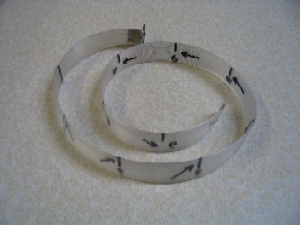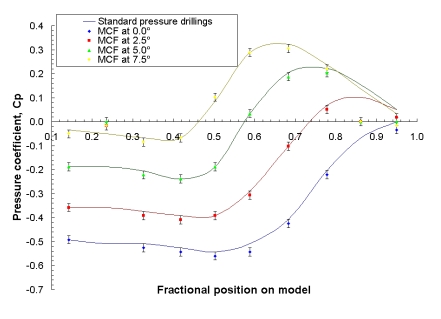Lead researcher: Dr Bart Hallmark
Assistance gratefully acknowledged from Dr Holger Babinsky and Mr. Thilee Thiagaraja, Dept. of Engineering, University of Cambridge.
Recent developments in the high-voidage MCF process coupled with the understanding of what polymer properties are ideally suited for it, have led towards the development of a novel pressure-sensing device. The sensory strip consists of a high-voidage MCF produced under carefully controlled conditions with a series of holes along its length that expose each capillary to the outside world at different points. One end of the MCF is then heat sealed and the other connected to pressure sensing equipment via a custom-made connection manifold. An example of one of the shorter strips is shown in the photgraph below.
 |
Initial characterisation of the measurement performance was carried out in the wind tunnels at Cambridge University Engineering Department by Mr. Thilee Thiagaraja under the supervision of Dr Holger Babinsky. The pressure strip was glued onto the underside of an aerodynamic surface within which were a series of conventional pressure tappings; the apparatus is shown in the photograph below.

The experimental results, shown below, are very promising at this early stage and demonstrate that the short MCF-based pressure strip reads the same pressures at steady-state as the conventional pressure tappings subject to experimental error. The solid lines in this plot are the readings from the conventional pressure tappings at all angles of attack whereas the discrete data points correspond to the reading obtained from the MCF strip.

We are currently collaborating with an instrument maker on prototype device for diagnostic dynamic pressure measurement for in-field use and a prototype is currently being evaluated by a team competing in this year's America's Cup.

